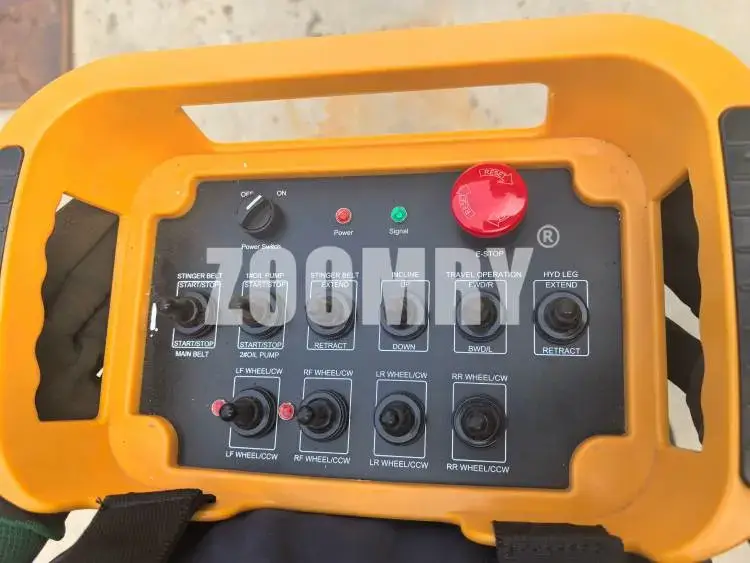Time:2025-05-05 10:48:12 Number of Clicks:
Truck unloaders serve as critical hubs in bulk material handling systems, tasked with efficiently unloading commodities like ores, coal, cement, and grains. Their operational environments often involve heavy vehicles, complex terrains, and high-intensity continuous operations, with safety risks frequently hidden in operational details. As a specialized manufacturer in bulk material handling with over two decades of experience, ZOOMRY integrates ISO 9001 quality management systems, CE/EAC international certifications, and insights from 200+ global projects to systematically outline five frequently neglected safety protocols for truck unloaders, helping enterprises achieve both safety and efficiency goals.

The operational stability of truck unloaders hinges on chassis design, yet many accidents stem from misjudging ground conditions and equipment support. ZOOMRY's accident case studies reveal three commonly overlooked aspects:
Pre-deployment geological surveys are essential, particularly for soft soil, sandy terrain, or slopes. ZOOMRY's ZRLD-TU series crawler unloaders feature multi-point hydraulic support systems that automatically adjust pressure distribution based on ground bearing capacity to prevent tilting from uneven settlement.
When handling viscous materials (e.g., wet clay), buildup on hopper walls can shift the center of gravity forward. Clean hopper sidewalls every 2 hours and install load sensors for real-time monitoring.
In tropical or polar regions, regularly check the friction coefficient between tracks/tires and the ground.
The hydraulic system is the powerhouse of truck unloaders, yet 80% of operators focus solely on pressure readings, neglecting these hidden risks:
High temperatures accelerate hydraulic cylinder seal degradation. Implement a "temperature-time" dual-assessment: at ambient temperatures >40°C, reduce seal replacement intervals from 2,000 to 1,500 hours.
While ISO 4406 classifies hydraulic oil cleanliness into 21 levels, most firms rely on visual inspection. For instance, when 5μm particles exceed 4,000/mL, gear pump wear triples. ZOOMRY's integrated oil monitoring module provides real-time contamination alerts.
During pipe ruptures, relief valves must respond in <0.5 seconds. Quarterly simulated overpressure tests with valve movement tracking are recommended.
Safety evaluations for conveyor belts require transcending conventional approaches:
Material impact angles >15° from the belt centerline induce shear forces. ZOOMRY's ZRLS-TU series employs bidirectional self-aligning idlers and laser guidance to limit misalignment to <2°.
Traditional vulcanized joints endure ~15,000 cycles, whereas ZOOMRY's patented stepped cold-bonding with aramid reinforcement exceeds 30,000 cycles.
For plastics or combustible dust, monitor surface resistivity. ZOOMRY's ATEX-certified anti-static belts (10^6-10^8Ω) eliminate spark ignition risks.
For inquiries about these 5 overlooked safety protocols, contact us:
Modern truck unloaders' intelligent controls demand redefined collaboration:
Systems auto-lock power and trigger alarms if "travel motors engage before arms fully retract," preventing mechanical collisions.
English/Spanish/Russian interfaces with industry glossaries eliminate translation errors for global operators.
Safety designs must address global operational complexities:
Coastal models use "hot-dip galvanizing + epoxy coating," achieving >3,000-hour salt spray resistance (vs. ISO 9227's 500-hour standard).
At >3,000m elevations (e.g., Andes), turbocharging and oxygen adjustment maintain 95%+ rated power output despite 18% engine derating.
Grain-handling units feature IP69K-sealed hoppers with UV sterilization to prevent mold/contamination.
Truck unloader safety transcends technology—it's a systemic discipline. Leveraging CNAS-certified labs (covering chemical analysis, roller endurance, etc.) and a global service network, ZOOMRY delivers end-to-end solutions from equipment selection to smart maintenance. Choosing CE/EAC/KCS-certified suppliers erects dual barriers of compliance and risk mitigation.
Copyright © 2002-2024 Zoomry Group Company Limited